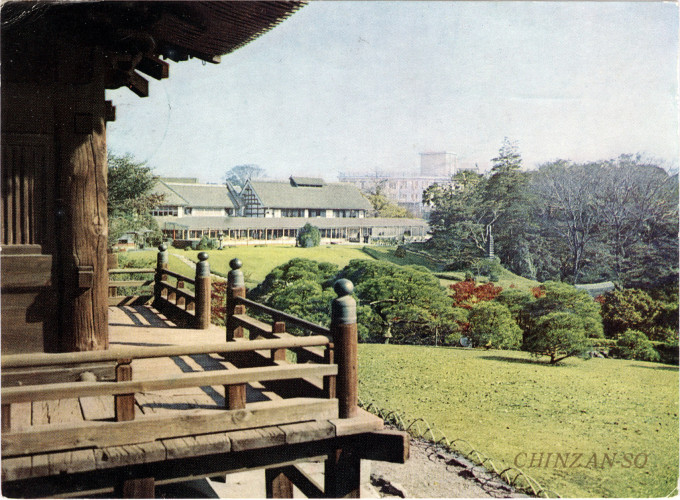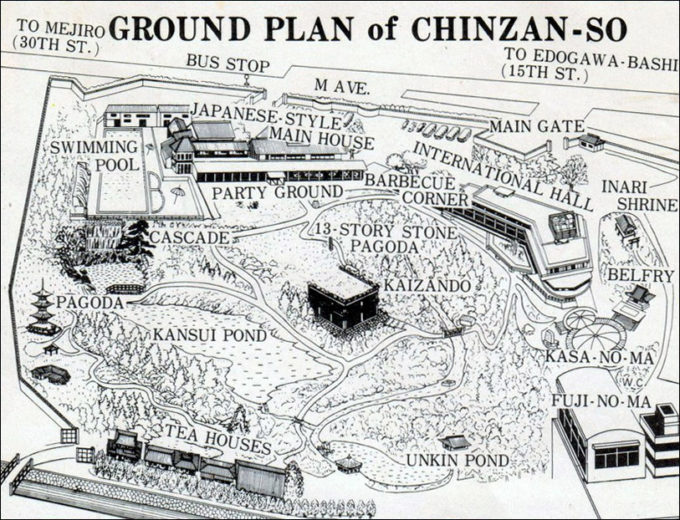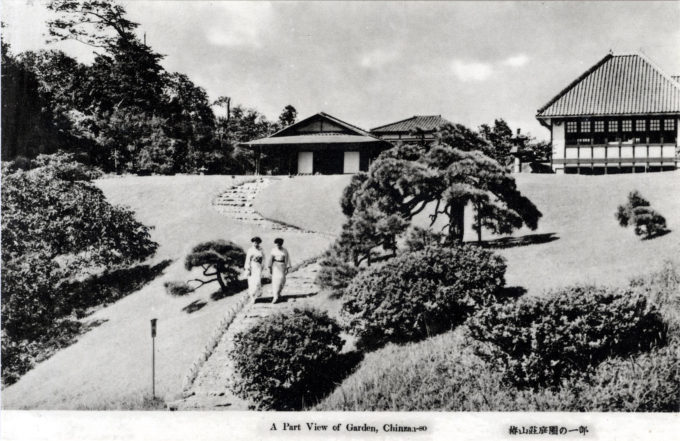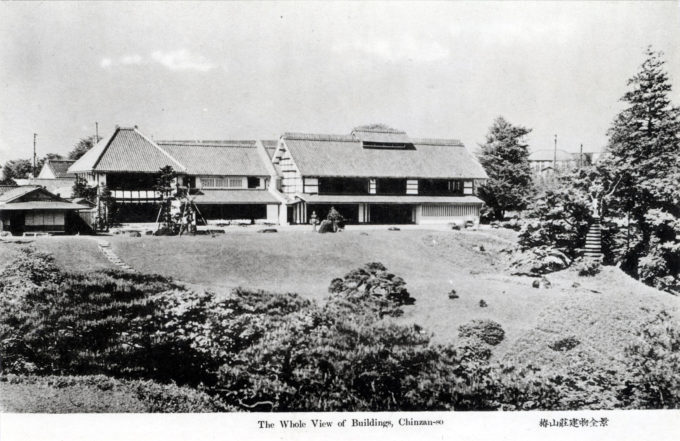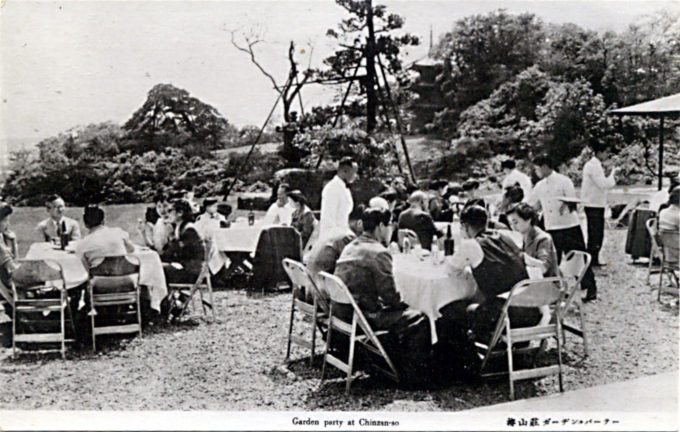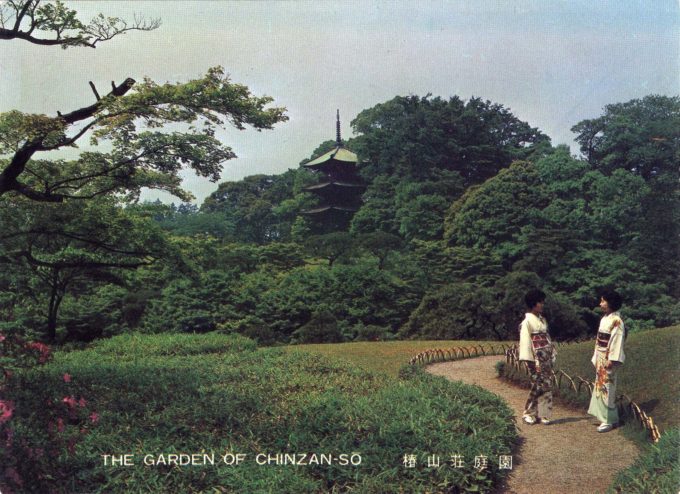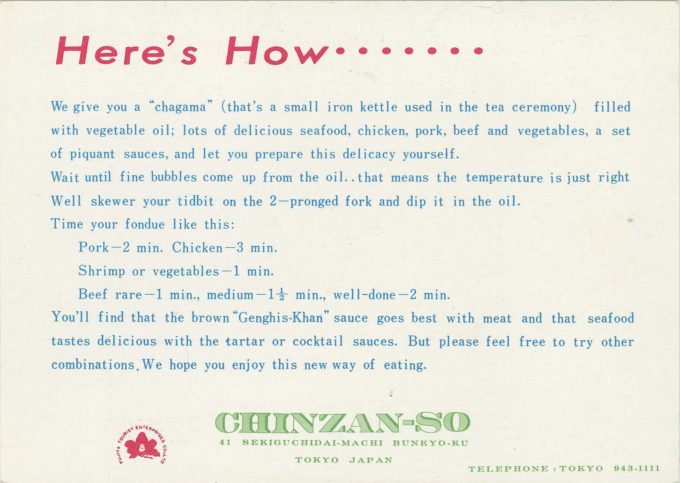“Perhaps the most famous of all Tokyo’s myriads of restaurants, and deservedly so, is the Chinzan-so, a superb garden restaurant in a 17-acre park so lovely and remote-seeming that patrons can imagine themselves many miles from the big, roaring metropolis.
“… Chinzan-so means ‘Camellia Mountain,’ but it is hardly that. More precisely, it is a hill-and-dale park with a brook running through it and with 8000 trees and handsome shrubs planted in it, all of them set out after fire bombs, launched on May 26, 1945, destroyed most of the previous vegetation, along with most of the buildings.
“Fortunately, they did not destroy a lovely 3-story pagoda built in the 9th century in Hiroshima Prefecture and moved to the Chinzan-so in 1924 by Baron Fujita, nor did they destroy an ancient Oratory that was likewise moved to the spot in 1924, this coming from Kyoto.
“… Every year from May 25th to June 25th the Chinzan-so has a Firefly Festival that is one of th exotic spectacles of Tokyo. From all over Japan fireflies gathered by country folk are dispatched to Tokyo at so much per hundred, or thousand, sparklers and the Chinzan-so alone claims or implies in its advertising, that it buys a million of them each year, to be loosed in the garden by the thousands every night during the month for the entertainment of its patrons.”
– All the Best in Japan (with Manila, Hong Kong & Macao), by Sydney Clark, 1958
- Chinzan-so, c. 1960.
- Chinzan-so, c. 1960.
“Chinzaso was built on land that was considered ideally suited for camellias to grow naturally. Former Prime Minister Yamagata Aritomo first built his residence here in 1878. It was converted to a hotel with banquet facilities in the mid-1900s, and has come to be known as the Hotel Chinzanso, Tokyo, welcoming elite international guests and hosting global conferences.
“In the gardens that have cleverly incorporated hills and dales, each of Japan’s four seasons is well represented by cherry blossoms in the spring, fresh green foliage in summer, jewel-like colors in autumn, and camellias in winter. In June, fireflies dance around the entire garden.”
– Artfully Walking Tokyo and Beyond, by Enoki Takaaki, 2016
“For over six centuries, the land surrounding Hotel Chinzan-so Tokyo has been home to wild camellias and, among other representations, was featured in a wood block print by the ukiyo-e artist Hiroshige Ando. The current name of the garden ‘Chinzan-so’ was given by Yamagata Aritomo, an influential member of a group of elderly statesmen known as the Genrō in the Meiji and Taishō eras, who came into possession of the Chinzan-so land.
“Yamagata was not only a politician but also an art connoisseur who wrote poetry and was fond of gardens. He developed the Garden with a Kaiyuu-style design, popular in the Edo Era. Kaiyuu gardens usually have vast green grasslands, a pond, a Tsukiyama (earth molded to look like a small mountain) and winding rivers.
“In 1918, reflecting the will of Yamagata, the property was assigned to Baron Fujita Heitaro. He respected the wishes of Mr. Yamagata, who insisted on leaving the place unchanged.
“In 1945, the Yamagata Museum, a mansion the size of five tennis courts, and most of the trees were burned down in the air raids of World War II. However, in 1948, in the aftermath of the war, the owner of the company (now known as Fujita Kanko), Mr. Eichi Ogawa, wanted to make a place where people could gather, so he planted 10,000 trees to revive Chinzan-so.
“On November 11, 1952, a grand opening ceremony for the new Chinzan-so garden, with a restaurant, took place. Ever since then, Chinzan-so has been known throughout Japan for its exquisite garden restaurants (nine in total, plus two bars and a café) and prestigious wedding facilities.”
– Wikipedia
- “Fondue Chinzan-so”, Tokyo, c. 1970. “A do-it-yourself treat!”
- The how-to of “Fondue Chinzan-so”, Tokyo, c. 1970.


